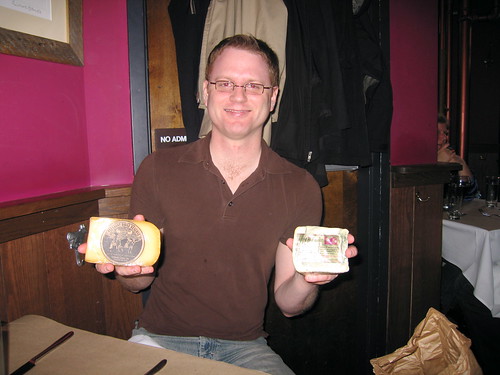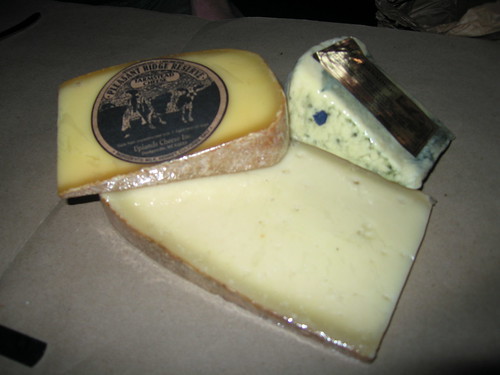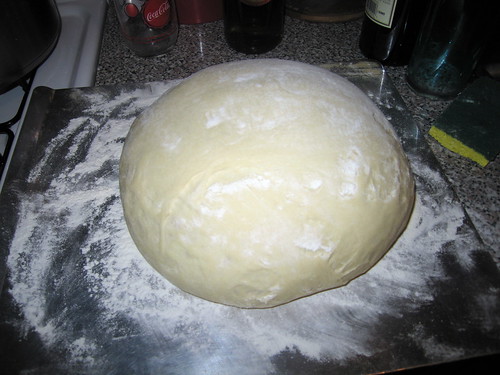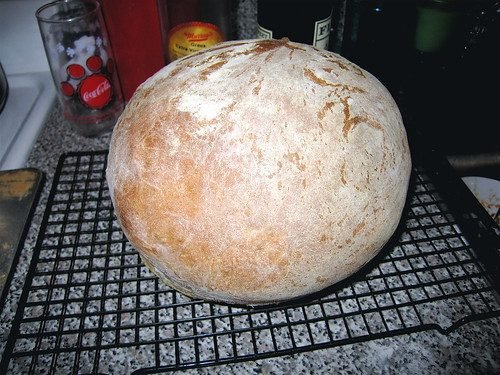Make Bread
Last week the NYT published a piece on how to make supremely excellent bread at home with minimal work and maximum reward. Luisa of Wednesday Chef attempted it and her results look marvelous. But the other day I wanted home-made bread and I wanted it then and there. The NYT technique requires 12 hours of resting and I was impatient, so what could I do?
The reason I wanted fresh bread so bad was because earlier in the day I received a gift from dedicated Madison, Wisconsin reader Joe B:

That's a cheese-eating grin on Joe's face and his gift was, indeed, cheese:

I'm sure he can tell us in the comments what cheeses they are, specifically, but one of the cheeses was recently voted best cheese by the National Dairy Counsel (or something, again: Joe, fill us in!)
Craig was most eager to eat these cheeses right away because Craig is a cheese nut. "Let's just buy crackers," said Craig and I heard the words, "Let's give up on life and be losers who don't care about anything." In other words: I needed to make bread from scratch.
"Wait," I told Craig, "I'm going to make bread from scratch."
"But that's going to take forever," said Craig. We were home at this point and he already tore the plastic off the first cheese.
"Well nibble on that but I have a recipe that'll be done in just a few hours."
The recipe I had in mind comes from none other than the subject of my Salon.com interview from a few weeks ago: Nigel Slater. It's in his book "Appetite" and the recipe is for "A Really Good and Very Easy White Loaf."
This is a recipe that should send you leaping out of your chair, into the grocery store, and straight to your kitchen. It's a recipe that makes it inexcusable not to make bread from scratch. I implore you, oh reader, if you're the least bit curious to make this bread---just for the tactile experience of making your own bread dough, kneading it and then watching it rise and finally baking it. The house fills up with the warmest of aromas and you'll be glad to be alive.
I'm so eager for you to make this bread I'll make you a deal. If you make this bread and take a picture of yourself with the end product, I'll post it on the site. Just send it to amateurgourmet AT gmail DOT com. Here's what you need:
8 cups white bread flour
2 packages rapid-rise active dry yeast
4 teaspoons salt
3 cups water
Here's Nigel's instructions:
Take your largest, widest mixing bowl and tip in the flour, yeast, and salt. Pour in almost all of the water and mix to a sticky dough. Keep mixing for a minute or so--the dough will become less sticky--then add a little more flour until you have a dough that is soft and springy and still slightly sticky to the touch.
Generously flour a large, flat work surface and scoop the dough out onto it. Work the dough with your hands, pushing it flat with your palms, then folding the far edge toward you and pushing it back into the dough with the heel of your hand. Continue pushing and folding the dough. WOrk firmly but gently, with none of that brutal banging people tell you about, folding and pushing the ball between your hands. It should feel soft, springy, and alive (which, of course, being full of yeast, it is). The technique is less important than you may have been led to believe. What is important is that you carry on gently but firmly pummeling the dough. As you do so, you will feel it get lighter and more springy. Keep this up for almost ten minutes. If you find it exhausting, then you are pushing the dough too hard.
Place the ball of dough back in the bowl, cover it with a clean tea towel, and put it somewhere warm, but not hot, for an hour or so. It should be well out of a draft. An airing cupboard is ideal. I don't have one, so I end up balancing the bowl on a thick towel over the radiator. The dough should almost double in size. The time this takes will depend on how hot or moist your room is, the exact type of flour you have used, and the age of your yeast, but it will probably be about forty-five minutes to an hour.
Once the dough has doubled in size, you need to tip it out onto the floured surface again, scraping out the dough that has stuck to the bowl, and give it another short session of pushing and squeezing; a couple of minutes will do fine. Bring the dough into a ball again and place it on a floured baking sheet. Dust it heavily with flour, then cover with a tea towel and return it to its warm place to rise again. Set the oven at 500 F. After an hour or so the dough will have spread and somewhat alarmingly. You want it to be twice its original size--or as near as damn it. Gently, and I do mean gently, tuck it back into a neat, high ball,

then place it softly in the hot oven. Don't slam the door.
Leave the loaf to bake for ten minutes, then turn the heat down to 425 F. After 25 or 30 minutes you can check the loaf for doneness. It should sound hollow when you tap its bottom. Like a drum. Let the loaf cool on a wire rack. Try not to cut straight into it; give it time to settle before slicing.

